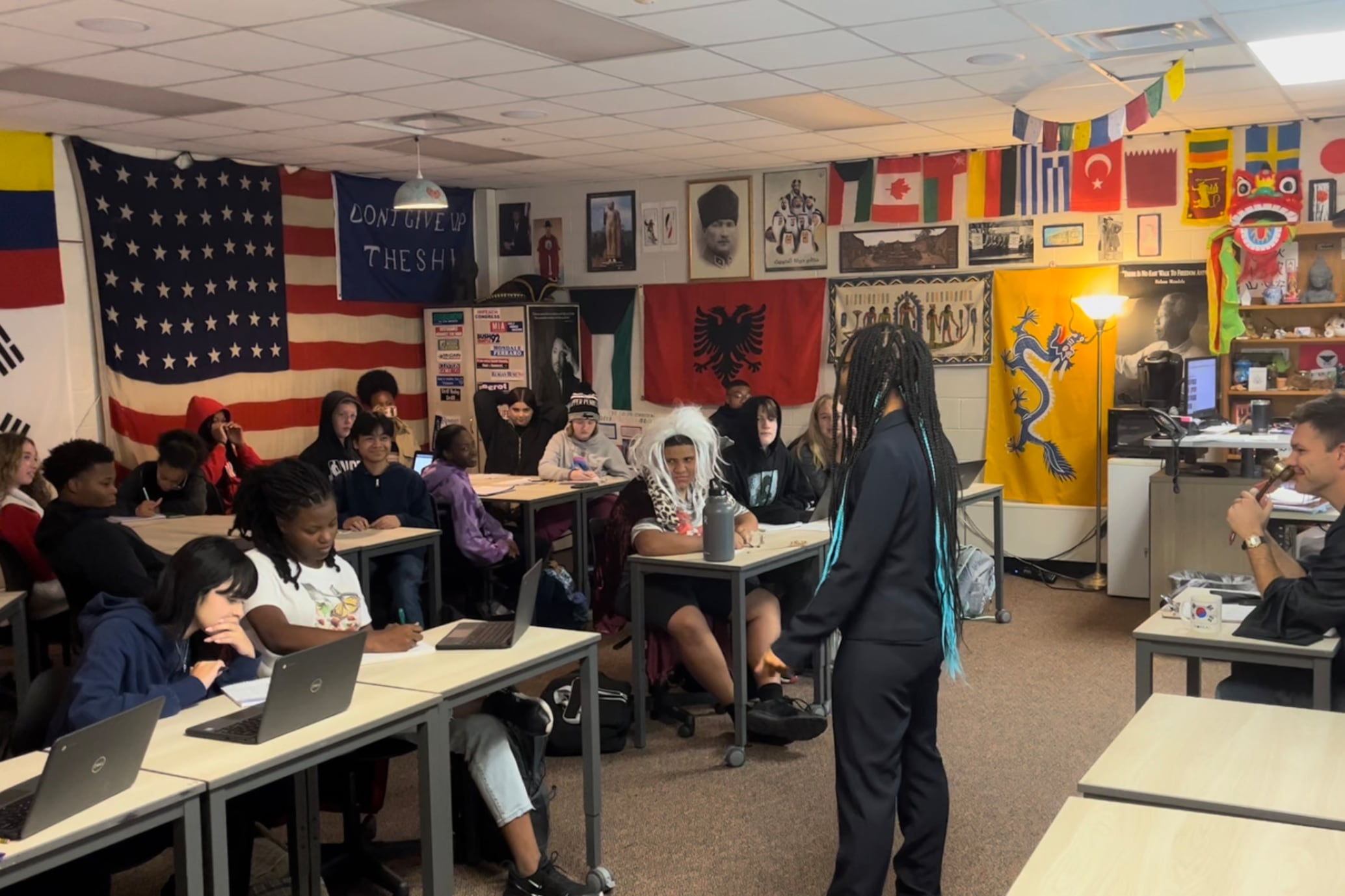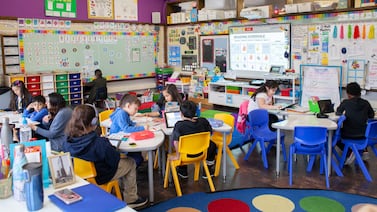Matt Vriesman was studying the work of leading professional historians during graduate school when he noticed over and over that there was a big gap between what historians have proven about race, slavery, and injustice, and what gets printed in state standards.
One textbook, for example, said Black Americans switched their allegiance from Republicans to Democrats because of relief checks during the Great Depression.
“The sentence that I found suspect was not only not true, it was not even debatable,” said Vriesman, a history teacher at East Kentwood High School who was recently named Michigan History Teacher of the Year. “It was a pure myth that served a purpose of minimizing racial injustice and Black agency.”
Vriesman teaches in one of the most diverse high schools in the state, and what he found during graduate school inspired changes to his own teaching lessons. But as much of the country was undergoing a racial reckoning after the murders of George Floyd and Breonna Taylor in 2020, a school administrator asked him to provide resources for other district educators.
That led to the creation of a website that includes 40 lesson plans that are tied to U.S. History content standards created by the College Board, which oversees advanced placement classes. Vriesman teaches Advanced Placement classes in U.S. History, African American Studies, and World History at East Kentwood High.
The website antiracistapush.com (the “apush” stands for AP U.S. History) helps teachers “go beyond notoriously softened high school text narratives,” Vriesman says on the page.

Vriesman came across that language, and other “shameful” gaps, while working on his graduate degree in history online. At the time, he was traveling in the Middle East and Asia for several years, teaching in Seoul and Kuwait City.
“They were some of the best years of my life,” said Vriesman, of his travels and teaching in the Middle East and Asia. “Why did I go? Adventure and to experience and learn as much about the world as possible.”
Now, he’s inspiring an appreciation of history and the world in Kentwood Public Schools, a west Michigan district near Grand Rapids. During a 16-year teaching career, Vriesman has found success connecting with students and inspiring them through their interests.
“It’s so exciting,” he says about seeing that interest sparked. “The world is such a fascinating place. Each student has passion and curiosity inside them, and I am so honored whenever I can play a small part in igniting these things.”
This interview has been lightly edited for length and clarity.
Was there a moment when you decided to become a teacher?
I realized when I was 14 and not starting on the JV baseball team that I probably would never become shortstop for the Detroit Tigers. Therefore I pursued my “fallback” career choice in education. Haha, no seriously, I have never wanted to be anything other than a history teacher.
How do you get to know your students?
It’s certainly not easy when you see 130 students every day. You need to make a concerted effort. Aside from common beginning-of-the-year “get to know you” activities, I try to greet students at the door every day and set aside class time for one-on-one meetings. I try to create a general class atmosphere where everyone feels welcome and valued. When students feel welcomed and free to be themselves, they tend to share a lot more, and these relationships are key for their growth as scholars.
Tell us about a favorite lesson to teach. Where did the idea come from?
The first is the “Gunpowder Empires” game. I created a mixture of [the games] Monopoly and Risk. Students are in teams surrounding a map with a grid. The teams represent either the Ottomans, Safavid, or Mughal empires. Not only do they need to strategize the best use of the new gunpowder technology, they must also engineer great architectural or cultural wonders (Taj Mahal, Shah Mosque, Miniature Paintings, etc.). This game was created after living in the Middle East for a few years and traveling throughout Turkey and India.
The second is “The Trial of King George” I created this after completing a fascinating class on the American Revolution in graduate school. Students use the charges found in the Declaration of Independence to accuse or defend King George. To the students’ surprise each year, the case becomes a lot closer than they originally thought. Some of Thomas Jefferson’s charges are quite flimsy to say the least. It always gets very heated. So fun!
What’s something happening in the community that affects what goes on inside your class?
One of the best parts of my job is that I get to teach World History in one of the most diverse school district in the state. Over 90 languages are spoken by our students. We are always looking for new ways to bring in the knowledge and experience of our students into the classroom. It makes world history so much more “real” for students. We aren’t just teaching a subject, we are teaching people.
Tell us about a memorable time — good or bad — when contact with a student’s family changed your perspective or approach.
I remember my first set of conferences the best, the first semester I taught, 16 years ago. One student was giving me quite a bit of trouble and my strategy basically devolved into trying to isolate him as much as possible so I could get on teaching the other 30 students. This student seemed to have no desire to learn about history, and I reasoned that I’d tried my best and now I just needed to survive the semester. In a way, I’d given up on him.
Then I met his mom who was working her tail off and believed in her son but seemed to be overwhelmed and exasperated by his struggles at school. I saw she was looking to me to do something. Me, the one with the college degree and training, the one who signed up to get into this work because I said that I believed in every student’s potential. She was looking at me to do my job, and I realized that I just needed to be better. I realized that “giving up” and surviving was not an option. I needed to start each day new and greet every student with the belief that they could succeed.
I don’t think the rest of the semester changed his life or anything. But we did end the year on solid terms, and he passed. When I saw him as a problem student, I was ineffective. When I saw him as somebody’s son, someone who deserved the best public education that I could deliver, I instantly became more effective.
What part of your job is most difficult?
There are so many good times in the classroom. But not every second of every lesson is as inspiring and engaging as I want it to be. In those times, even after 16 years, I still find it very easy to start to question my ability to do this job. It’s hard, and we need to continue to affirm one another. It’s not going to look like you planned it every day, but in the end, sometimes you need to evaluate yourself based on effort and intention and cannot beat yourself up by outcomes. Adjust and move on!
Speaking of challenges, how have current debates about the teaching of historical events affected you in the classroom?
They have only empowered me and made my classes more interesting! It used to be harder to convince students that history class matters. The adults are doing a good job of proving that, and they are also giving us wonderfully relevant fodder to dissect and discuss.
Recommend a book that has helped you become a better teacher, and say why.
A love of reading is one of the key things that makes me a good teacher. I love to learn new things about how the world works, and I update my curriculum every year because of it. I don’t actually read many books about teaching, but I am typically reading two books about history at all times. The books I read this summer that have most helped to revive and sustain my love of learning are “The Black Count” by Tom Reiss and “Thomas Sankara: A Revolutionary in Cold War Africa” by Brian Peterson.
A book about teaching I would recommend is “Teaching Black History to White People” by Dr. Leonard Moore. I highly recommend it to all citizens, not just history teachers. The book starts with this line, “All white people should take a Black history class … although this seems like a radical statement, it is actually rooted in reason and practicality…”
A proper understanding of Black America’s struggle for liberty is key for “racial reparations, racial healing, and racial reconciliation,” the book says.
What’s the best advice you’ve received about teaching?
If you have a high AP passing rate, but your classroom does not look like your hallways (meaning the demographics of your AP classroom do not represent the diversity of your community) then you are not doing a good job. You are perpetuating the racial opportunity gap and you need to do better. Fueling your ego with impressive “score report stats” may lead to unintentional “gate keeping” where you push students into your class because you think they will help your score but advise other students to avoid the class. Instead, reach out to all learners, specially looking for students who may have never had a friend or family member take an AP class. Open up opportunities and do your part to shrink the shameful racial opportunity gap in American education. Your career can have a higher and more meaningful purpose.
What are some techniques you use to get students excited about history?
No. 1 You have to be evidently interested in the topic and understand why this lesson is important for student’s humanity, personal development, and future health of our community and democracy. If you are not into it, there is no chance that the teenagers will be.
No. 2 Memorizing dates and names is boring and not what historians actually do. I hear people say that they don’t like history, and it makes me sad. History is exhilarating. It is the very act of challenging common notions about why our reality is the way that it is. Historians don’t read books to memorize them, they read books to challenge them. We read books like a detective leaning over the suspect and challenging every claim. That’s exciting.
No. 3 You can turn almost any topic into a choose your own adventure game/debate.
What topics in history do you find your students are most interested in? What inspires them?
Students are most inspired when they feel called into the work of making our society live up to its original stated values. If you ask students what they think is required from a society to make it a good one to live in, just about every student will describe the basic classic liberal values that are described in the founding documents of this country. I find that the most engaging social studies class, while critical of the past and present institutions, makes students much more likely to want to become civically engaged.
Lori Higgins is the bureau chief for Chalkbeat Detroit. She can be reached at lhiggins@chalkbeat.org.







